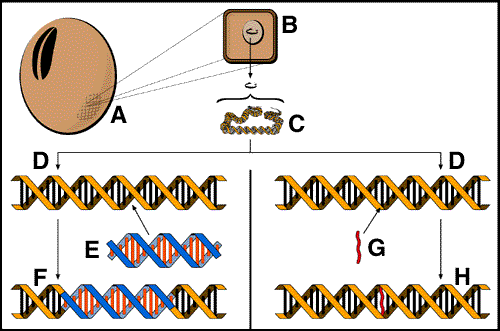READ: Artificial Selection
Artifical Selection: Genetic Manipulation
While selective breeding continues in plants and animals by farmers and breeders, modern selective breeding techniques involve modifying the organism’s genome (DNA). A genetically modified organism (GMO) has a gene for a desired trait manually inserted into its genome. The magnitude of genetic change in genetically modified organisms is very different than its natural variety. The figure below illustrates how a natural genetic change is different in method and magnitude of genetic change. Plants and seeds (A) consist of many cells (B). Chromosomes in the cell (C) contain DNA molecules (D) that store genetic information. Millions of individual nucleotides make up the DNA information in a single cell. With GMOs, new genes are introduced into the cell (E) that could come from any living thing. This gene will contain the information to control a desired trait. The transgene inserts into the plant's chromosome (F) and becomes a permanent addition to the genetic information in the plant. With non-GMO crops, changes as minor as a single nucleotide change (G) in an existing gene create a new version of the gene (H) that controls a new trait in the plant. These changes can occur from natural mistakes in DNA replication or be induced by chemical treatments.

Currently, this technique is used commercially in plants and only experimentally in animals. This technique is very controversial and cutting edge at the same time. Supporters say that genetically modified foods could end world hunger while critics say the risks are still unknown and warns of “super pests” (genetic changes resulting in unwanted traits). The most common products derived from genetically modified crops are soybeans, corn, canola oil, cotton seed oil, and wheat. Current estimates say that 60% of processed food contains genetically modified ingredients . Genetic modification has resulted in rice with an inserted vitamin A gene. This rice was created to reduce blindness in poor countries that suffer from vitamin A deficiency. A variety of GMO fruits and vegetables have inserted genes to slow decomposition. Thus, increasing shelf life and reducing financial loss due to rotting fruit. The future of GMO may result in fruit with vaccines for childhood diseases, plants more resistant to drought and frost (lengthening the growing seasons), or potatoes that absorb less fat when fried. The products “invented” using this technology may be unlimited. The future of GMOs may also involve livestock. The Food and Drug Administrations recently has determined that meat and milk from cow, pig, and goat clones are safe to include in the food supply. The first approved genetically modified animal for US consumer markets may be the Aqua Bounty salmon. This salmon variety has a growth-hormone gene inserted from the Chinook salmon. The modified Aqua Bounty salmon reaches market weight in about 18 months instead of 30.
Critics are rightfully concerned about the formation of super weeds, new diseases, and other unanticipated result of genetic manipulation. Critics are especially concerned about this technique being applied to animals, including humans, as the result may be cruel to the resulting individual. The worst case scenario that critics warn about is that science may create a new organism that spawns a fatal epidemic.